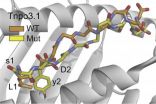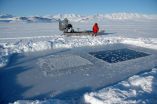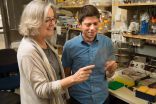(Press-News.org) Scientists have found a way to find the proverbial needle in the cancer antigen haystack, according to a report published in The Journal of Experimental Medicine.
As cancer cells divide, they accumulate random mistakes (mutations). This process creates new versions of proteins, some of which are recognized as foreign invaders by immune cells called T cells, prompting the cells to attack and eliminate the cancer cells. With our current ability to identify all of the mutations in a patient's cancer and to understand which protein sequences can be recognized by T cells, scientists can now predict which mutations will result in new T cell targets (called "neoepitopes"). Some of these neoepitopes can then be used as vaccines to elicit a protective T cell response that destroys the cancer.
But here's the catch. These prediction tools generate hundreds of possible neoepitopes, of which only a handful can actually elicit T cells capable of attacking the tumor. And so far, there has been no reliable common denominator to help pinpoint this useful handful.
Previous attempts to predict cancer neoepitopes have relied on how strongly the mutated protein is recognized by the immune system. But scientists at the University of Connecticut now show that the strength of this interaction is a poor predictor. A better (albeit still imperfect) measure turns out to be how different the mutation looks to the T cell when compared to its normal counterpart—the more distinct, the better. These results have the potential to completely change current approaches to generating anticancer vaccines.
INFORMATION:
Duan, F., et al. 2014. J. Exp. Med. doi:10.1084/jem.20141308
About The Journal of Experimental Medicine
The Journal of Experimental Medicine (JEM) is published by The Rockefeller University Press. All editorial decisions on manuscripts submitted are made by active scientists in conjunction with our in-house scientific editors. JEM content is posted to PubMed Central, where it is available to the public for free six months after publication. Authors retain copyright of their published works and third parties may reuse the content for non-commercial purposes under a creative commons license. For more information, please visit http://www.jem.org .
Research reported in this press release was supported by Cancer Research Institute NY, Northeastern Utilities, Connecticut Institute for Clinical and Translational Science, SPARK, the National Science Foundation, the National Institutes of Health, Life Technologies, and the USDA National Institute of Food and Agriculture.
New rules for anticancer vaccines
2014-09-22
ELSE PRESS RELEASES FROM THIS DATE:
Classroom intervention helps shy kids learn
2014-09-22
A program that helps teachers modify their interactions with students based on an individual's temperament helps shy children to become more engaged in their class work, and in turn, improves their math and critical thinking skills.
Led by NYU's Steinhardt School of Culture, Education, and Human Development, the study offers an evidence-based intervention to help shy children, who are often at risk for poor academic achievement. The findings appear in the Journal of School Psychology.
Shy children are described as anxious, fearful, socially withdrawn, and isolated. ...
Arctic sea ice helps remove CO2 from the atmosphere
2014-09-22
Due to global warming, larger and larger areas of sea ice melt in the summer and when sea ice freezes over in the winter it is thinner and more reduced. As the Arctic summers are getting warmer we may see an acceleration of global warming, because reduced sea ice in the Arctic will remove less CO2 from the atmosphere, Danish scientists report.
"If our results are representative, then sea ice plays a greater role than expected, and we should take this into account in future global CO2 budgets", says Dorte Haubjerg Søgaard, PhD Fellow, Nordic Center for Earth Evolution, ...
Nurse survey shows longer working hours impact on quality of care
2014-09-22
Results of a survey of more than 30,000 nurses across Europe show that nurses who work longer shifts and more overtime are more likely to rate the standard of care delivered on their ward as poor, give a negative rating of their hospitals safety and omit necessary patient care.
Led by researchers at the University of Southampton and the National Nursing Research Unit (NNRU) at King's College London, the RN4CAST survey of nurses in over 450 hospitals across 12 European countries, was part of an international research programme looking at links between nursing workforce ...
Singapore researchers discover a gene that increases incidence of AML
2014-09-22
A novel study by the Cancer Science Institute of Singapore (CSI Singapore) at the National University of Singapore (NUS) found that an increase in a gene known as Leo1 affects other genes that are directly implicated in acute myelogenous leukaemia (AML), increasing the incidence of cancer.
Led by Associate Professor Chng Wee Joo, Deputy Director and Senior Principal Investigator at CSI Singapore and Director of the National University Cancer Institute, Singapore, the scientists discovered that inhibition of Leo1 and Leo1 downstream signalling pathways provide an avenue ...
New guidelines issued for managing peri- and postoperative atrial fibrillation
2014-09-22
Beverly, MA, September 22, 2014 – The American Association for Thoracic Surgery (AATS) has released new evidence-based guidelines for the prevention and treatment of perioperative and postoperative atrial fibrillation (POAF) and flutter for thoracic surgical procedures. The guidelines are published in The Journal of Thoracic and Cardiovascular Surgery.
"These guidelines have the potential to prevent the occurrence of atrial fibrillation in thousands of patients who undergo lung surgery in the United States each year. The AATS is committed to its goal of improving the ...
Evidence supports deep brain stimulation for obsessive-compulsive disorder
2014-09-22
September 22, 2014 – Available research evidence supports the use of deep brain stimulation (DBS) for patients with obsessive-compulsive disorder (OCD) who don't respond to other treatments, concludes a review in the October issue of Neurosurgery, official journal of the Congress of Neurological Surgeons (CNS). The journal is published by Lippincott Williams & Wilkins, a part of Wolters Kluwer Health.
Based on evidence, two specific bilateral DBS techniques are recommended for treatment of carefully selected patients with OCD, according to a new clinical practice guideline ...
Involving female offenders in release planning can increase reintegration success
2014-09-22
TORONTO, Sept, 22, 2014--Women who are about to be released from prison need to be more involved in their discharge planning if they are to successfully reintegrate into their communities and avoid returning to prison, according to a new study.
Almost half of all female prisoners are back behind bars within one year of their release and most have multiple prison terms, mainly for drug-related offenses.
Dr. Flora Matheson, a researcher at St. Michael's Hospital, conducted one-on-one interviews with women who were about to be released or had been recently released from ...
Scientists discover an on-off switch for aging cells
2014-09-22
La Jolla -- Scientists at the Salk Institute have discovered an on-and-off "switch" in cells that may hold the key to healthy aging. This switch points to a way to encourage healthy cells to keep dividing and generating, for example, new lung or liver tissue, even in old age.
In our bodies, newly divided cells constantly replenish lungs, skin, liver and other organs. However, most human cells cannot divide indefinitely–with each division, a cellular timekeeper at the ends of chromosomes shortens. When this timekeeper, called a telomere, becomes too short, cells can no ...
Where is that spacecraft?
2014-09-22
Philadelphia, PA—Space surveillance is inherently challenging when compared to other tracking environments due to various reasons, not least of which is the long time gap between surveillance updates. "Unlike the air and missile defense environments where objects are frequently observed, the space surveillance environment data is starved, with many objects going several orbital periods between observations," according to researcher Joshua Horwood. "Thus, it is more challenging to predict the future location of these sparsely-seen objects and they have a tendency to get ...
Neurosurgery tackles past, current and future concepts of sports concussion
2014-09-22
September 22, 2014 - An estimated 1.68 to 3.8 million sports-related concussions occur in the United States each year, and there are likely a significant number that go unreported. Current Concepts in Sports Concussion is a comprehensive, 16-article supplement of Neurosurgery, official journal of the Congress of Neurological Surgeons. Chicago-area neurosurgeon Gail Rosseau, MD, the lead guest editor, is well known for her longtime commitment to sports-related head injury prevention, and serves on the Board of Directors of USA Football and ThinkFirst. Additional guest editors ...



